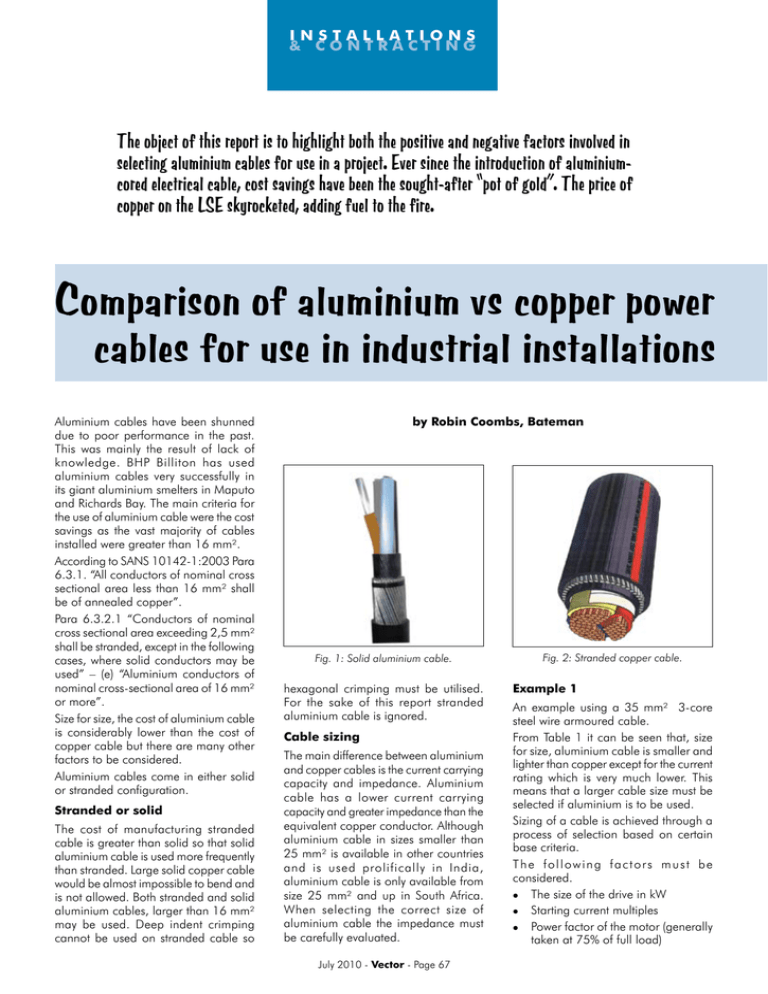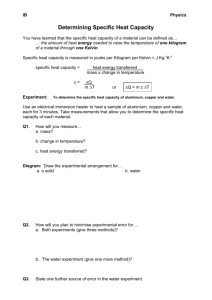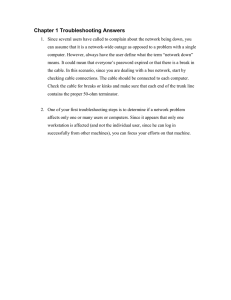Comparison of aluminium vs copper power cables for use in
advertisement

INSTALLATIONS & CONTRACTING The object of this report is to highlight both the positive and negative factors involved in selecting aluminium cables for use in a project. Ever since the introduction of aluminiumcored electrical cable, cost savings have been the sought-after “pot of gold”. The price of copper on the LSE skyrocketed, adding fuel to the fire. Comparison of aluminium vs copper power cables for use in industrial installations Aluminium cables have been shunned due to poor performance in the past. This was mainly the result of lack of knowledge. BHP Billiton has used aluminium cables very successfully in its giant aluminium smelters in Maputo and Richards Bay. The main criteria for the use of aluminium cable were the cost savings as the vast majority of cables installed were greater than 16 mm². According to SANS 10142-1:2003 Para 6.3.1. “All conductors of nominal cross sectional area less than 16 mm² shall be of annealed copper”. Para 6.3.2.1 “Conductors of nominal cross sectional area exceeding 2,5 mm² shall be stranded, except in the following cases, where solid conductors may be used” – (e) “Aluminium conductors of nominal cross-sectional area of 16 mm² or more”. Size for size, the cost of aluminium cable is considerably lower than the cost of copper cable but there are many other factors to be considered. Aluminium cables come in either solid or stranded configuration. Stranded or solid The cost of manufacturing stranded cable is greater than solid so that solid aluminium cable is used more frequently than stranded. Large solid copper cable would be almost impossible to bend and is not allowed. Both stranded and solid aluminium cables, larger than 16 mm² may be used. Deep indent crimping cannot be used on stranded cable so by Robin Coombs, Bateman Fig. 1: Solid aluminium cable. hexagonal crimping must be utilised. For the sake of this report stranded aluminium cable is ignored. Cable sizing The main difference between aluminium and copper cables is the current carrying capacity and impedance. Aluminium cable has a lower current carrying capacity and greater impedance than the equivalent copper conductor. Although aluminium cable in sizes smaller than 25 mm² is available in other countries and is used prolifically in India, aluminium cable is only available from size 25 mm² and up in South Africa. When selecting the correct size of aluminium cable the impedance must be carefully evaluated. July 2010 - Vector - Page 67 Fig. 2: Stranded copper cable. Example 1 An example using a 35 mm² 3-core steel wire armoured cable. From Table 1 it can be seen that, size for size, aluminium cable is smaller and lighter than copper except for the current rating which is very much lower. This means that a larger cable size must be selected if aluminium is to be used. Sizing of a cable is achieved through a process of selection based on certain base criteria. The following factors must be considered. l The size of the drive in kW l Starting current multiples l Power factor of the motor (generally taken at 75% of full load) Copper conductors Aluminium conductors Current rating in air 135 A 93 A Impedance 0,627 Ω/km 1,043 Ω/km Cable diameter 30,5 mm 27 mm Cable mass 2,08 kg/m 1,4 kg/m Bending radius 305 mm 270 mm Table 1: Comparison of cable characteristics Type of starter (direct on line, variable speed, soft start, etc.) l Derating factors for altitude, ambient, multiple cables on racks, solar radiation l Length of cable from the power source (DB/MCC) to the equipment (control panel, motor) l Type of cable insulation l Fault level of the system For the purpose of this report only balanced three phase electric motor drives fed from a central motor control centre are considered. Lighting and small power is excluded. Cable derating is ignored and only direct on line starting is assumed. System fault level is ignored. l Example 2 Motor: 90 kW Line voltage: 550 V 50 Hz Full load current (FLC): 120,81 A Power factor of motor at 75% of full load: 0,84 lagging Starting factor: 7,6 times FLC Cable insulation: PVC/SWA/PVC Volt drop under running conditions not to exceed 5% of nominal voltage Volt drop under starting conditions not to exceed 15% of nominal voltage. Current ratings in air Copper cable Aluminium cable 35 mm² 3 core pvc/swa/pvc 135 A 93 A 50 mm² 3 core pvc/swa/pvc - 110 A 70 mm² 3 core pvc/swa/pvc - 145 A Table 2: 70 mm² aluminium cable would be the smallest allowed. Data calculated with a cable length of 100 m Volt drop under running conditions Volt drop under starting conditions Result Cable size using copper conductors 35 mm², 3 core PVC/SWA/PVC/PVC/Cu 2,15% 7,42% Cable suitable Cable size using aluminium conductors: 70 mm², 3 core PVC/SWA/PVC/PVC/Al. 2,37% 5,14% Cable suitable Table 3: Example 2. Data calculated with a cable length of 100 m Volt drop under running conditions Volt drop under starting conditions Result Cable size using copper conductors: 35 mm², 3 core, PVC/SWA/PVC/PVC/Cu. 4,30% 14,85% Cable suitable Cable size using aluminium conductors: 70 mm², 3 core, PVC/SWA/PVC/PVC/Al 2,74% 10,28% Cable suitable Table 4: Example 2. July 2010 - Vector - Page 68 From Tables 3 and 4 it can be seen that by using aluminium cable, the selected cable will be two sizes larger. Using our example if a copper cable is used, a 35 mm² is suitable whereas using aluminium cable, a 70 mm² is required. Terminations When terminating copper conductors tin plated copper lugs are crimped on to the conductor with a hexagonal crimping tool. This results in a solid copper to copper joint that can be bolted onto the terminating copper connection. When terminating aluminium conductors a different approach is required. The lug must be a special Al-Cu type such that the aluminium cable core is crimped into the aluminium tube which is bonded to the (bi metallic) copper spade. This can now be safely connected to the copper connection. The crimping tool for this type of lug is not hexagonal but a circular deep indent, two of which are required. This indent pierces through the outer layer of aluminium thus passing through the aluminium oxide layer of the outer skin. This applies to solid aluminium conductors. A hexagonal crimp can be used provided that certain precautionary steps are taken. The outer skin of aluminium cores develops an aluminium oxide layer that reduces electrical conductivity. To allow the use of hexagonal crimping this layer must be completely removed and the surface “roughed up” immediately prior to crimping. For this reason hexagonal crimping of solid conductors is not recommended. If an aluminium conductor is crimped into a copper lug, two things happen. l An electrolytic reaction takes place when moisture is introduced, causing corrosion. l The temperature coefficient between aluminium and copper is such that when heated, under load, the two metals expand and contract at a different rate. (17 x 10-6 for copper and 23 x 10-6 for aluminium) This causes looseness within the crimp with subsequent overheating and finally failure. This can also be the cause of fires. Size of lugs There is a large difference between the size of copper and bi-metallic lugs. Using our example a standard 35 mm² copper lug is 37 mm long whereas a ALU300 R21 - P36 T2 Finnish AI conductor Type no for punch and matrix temperaturein mm2 class Type no for when cripming punch and matrix when performing 16 Stud size Fig. 3: All indent crimping sequence. Cu 240 - 30 70 mm² bi-metallic lug is 86 mm long. Thus it can be seen that, in most instances, more space is required for terminations. This can result in the terminating box being too small, requiring the addition of a larger box. In many instances this is not physically possible so an additional interconnection box needs to be introduced where the aluminium cable is terminated on to short bars and the smaller copper cable connecting to the motor. It would be preferable to install local isolators where this aluminium/copper transition can take place. Cu-conductor Type no for hexagonal die in mm2 ALU 300 - R21 - P36 T2 See above Fig. 4: Termination lugs and ferrules. Availability (South Africa) Both copper and aluminium cable have the same delivery periods although aluminium, as it is not as popular, cannot readily be sourced in a hurry. It is manufactured on demand whereas copper cable is kept in stock. The order quantities are the same as are the drum lengths. Copper lugs are manufactured in SA so are readily available. Bi-metallic lugs are imported but the local stockist carries a fairly large consignment. Availability in remote locations could be a real problem. Vibration and corrosion Aluminium cable is prone to cracking and failure when subjected to vibration. In nearly all electrical installations vibration is present. Motors and transformers produce vibration so the use of aluminium cable will be more susceptible to cracking than copper (quote from the Electrical Contractors Association). There are recorded cases of aluminium overhead lines failing due to Aeolian (wind generated) vibration. Vibration damage is even more serious in solid aluminium conductors. Aluminium has excellent corrosion resistance but this is only true for aircraft grade aluminium and coated aluminium as used in window frames etc. Aluminium used for cables corrodes when installed in damp conditions so is not really suitable for damp process plants and Fig. 5: Comparative dimensions. is not recommended (quote from the Electrical Contractors Association). Contrary to the above, aluminium cables have been used successfully on the Mozal and Hillside aluminium smelters, both at high humidity coastal locations, where no vibration cracking or corrosion have been experienced. The only failures experienced are where inadequate measures were taken in the selection of lugs or masking with corrosion-inhibiting Denso putty or tape. All motors were fitted with local isolators where the transition from aluminium to copper cable took place and no vibration was transmitted to the aluminium cable from the motor. The 360 kA DC open aluminium bus bar system displayed no symptoms of corrosion and no special precautions were taken to protect it from the elements. Installation The qualification of the installation electrician is the same for both copper and aluminium. Aluminium is more difficult to work with so the cost of termination is higher. On average the additional cost is in the region of July 2010 - Vector - Page 70 12 to 15% of the cost of termination. The actual installation of the cable on to racks costs the same. Cable support Aluminium cable is smaller and lighter than copper but due to the increase in size a slightly larger ladder support may be required in some instances. If, as in our example, there were 10 drives following the same route then the size of ladder required for copper cables would be 305 mm wide whereas for aluminium cable it would be 330 mm wide. A 400 mm wide rack would be chosen. The mass of copper cable on that rack would be 21 kg/m whereas the aluminium would be 20 kg/m, thus not much different. Costing Aluminium cables are cheaper than copper. Using our example we get the following: 35 mm² 3 core PVC/PVC/SWA/PVC/Cu cable – R 140,36/m (2007) Fig. 6: 360 000 A DC positive aluminium busbar installation. Cost of Cu cables greater than 16 mm² R5 203 735 27% saving on above R1405 008 Additional cost for junction boxes at motors R425 000 Additional cost of cable from junction box to motor R169 556 Mounting of junction boxes R34 000 Cable cost savings R776 452 Table 5: LV cables. A typical South African process plant project (2007) All cables of 25 mm² and greater from the cable schedule were used to evaluate the possible savings by using aluminium cable in place of copper. The following costs were extrapolated using the estimated saving percentage from this report. 70mm² 3 core PVC/PVC/SWA/PVC/Al cable – R 98,55/m (2007) Thus for an installed length of 200 m l Using 35 mm² copper cable costs R28 072 l Using 70 mm² aluminium cable costs R19 710 This shows a significant saving but the additional cost of lugs and labour must be added. A hidden cost is the requirement of larger enclosures/ terminal boxes that is rather difficult to quantify. l Cost of 35 mm² copper lugs R10,75 ea x 6 = R64,50 l Cost of 70 mm² bi metallic lugs R68,35 ea x 6= R410 Cost of cable R1 492 815 Estimated 18% savings R268 706 Total savings for the use of Al cable R1 045 158 Table 6: HV cables. The termination labour cost of 35 mm² copper 3-core cable is R151,67 thus terminating both ends costs R303,34. Termination labour of a 70 mm² aluminium 3 core cable is R225,72 thus terminating both ends costs R451,40. Total installed cost for copper cable is R28 166,84. Total installed cost for aluminium cable is R20 571,40. Saving by using aluminium cable is R7595,44 per drive of 90 kW (±27%). Summary The use of aluminium cable is significantly cheaper than copper so when used on a project, the cable costs will be considerably less and, depending on the July 2010 - Vector - Page 71 amount of large cables involved, could present considerable cost savings. The cost of lugs is, conversely, much greater than copper. Added to this is the additional cost of labour as aluminium cable is more difficult to work with. The cost of tooling is also higher but, obviously, not to the same extent. The biggest drawback to the use of aluminium cables is the risk factor. l Once an aluminium cable has been installed it cannot safely be moved. Further, when handling aluminium cable great care must be exercised to ensure that it is not bent too many times as this leads to cracking. l The bending radius of aluminium cable is smaller than that of copper but, once bent, it cannot safely be straightened. l Great care must be taken in applying moisture inhibiting putty or grease on all joints to prevent electrolytic reaction. l Corrosion can be a serious risk factor in damp conditions. Providing that the associated risk is acceptable and the correct installation methods are strictly applied then the use of aluminium cable can result in approximately 27% savings for the supply and installation of cables. Contact Robin Coombs, Bateman NV (retired), Tel 011 849-1527, rcoombs@iburst.co.za


